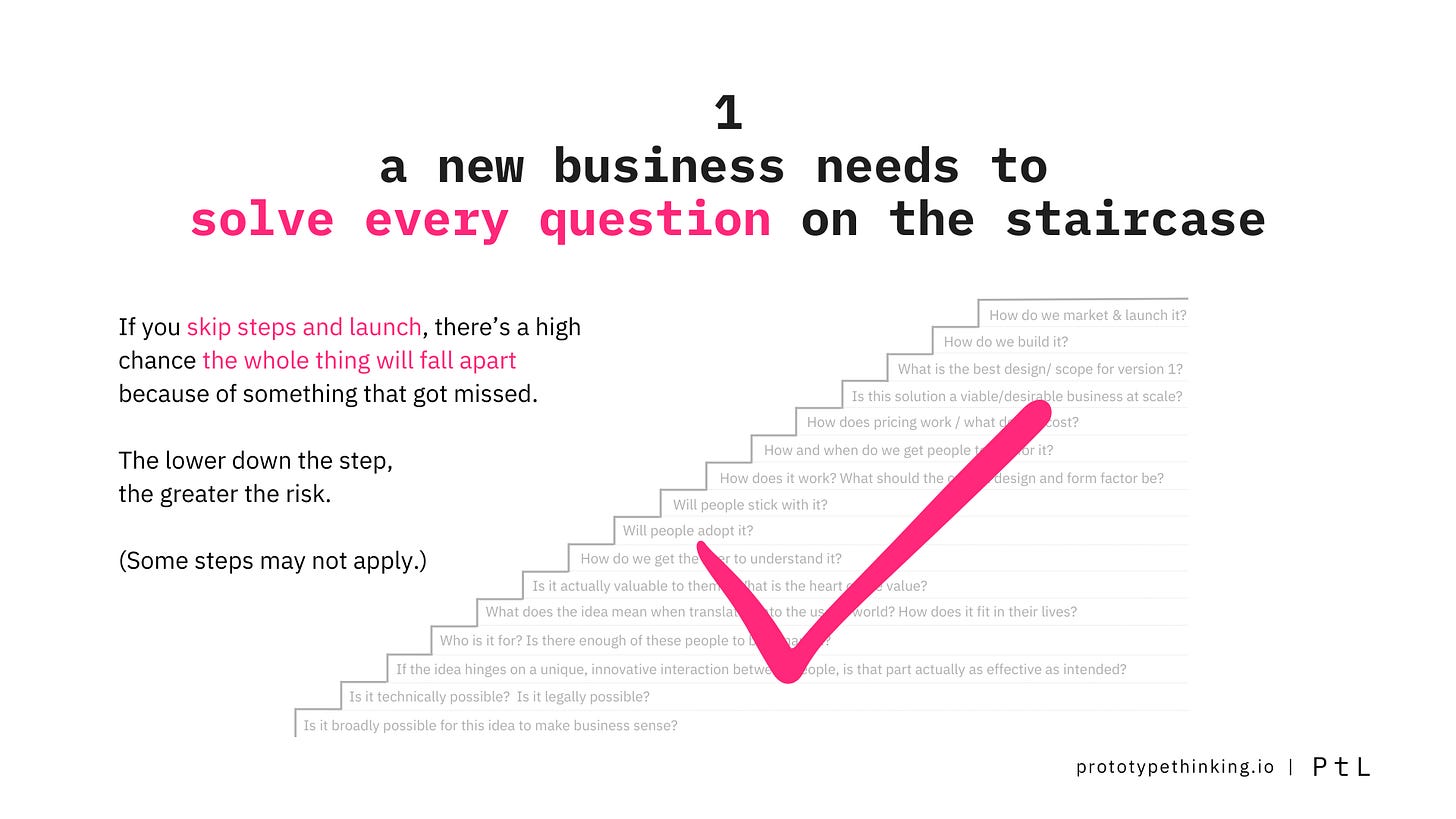The Product-Market Fit Staircase Self-Assessment
Score where you are on the step-by-step de-risking journey to product/market fit
The core of our product-market fit approach at Prototype Thinking Labs has always been:
In early innovation, when results are uncertain, roadmap your journey and navigate by questions. Start with the riskiest first, test your questions one at a time, and you’ll always be able to make clear, reliable progress towards finding the right solution that customers will love.
After doing this manually for a decade, I finally sat down this spring and synthesized the risk journeys of the hundreds of businesses and projects that we’ve worked with into a single common pathway.
The result is this tool: The Product-Market Fit Staircase.
The PMF Staircase is a quickstart self-assessment that allows founders to visualize their PMF journey, identify their load-bearing risks, and plan an efficient testing roadmap to a successful product.
(Note: For this post, we will be using the PMF Staircase for companies selling to consumers because it’s easier to visualize. The enterprise version will follow shortly. The principles are the same, but the literal steps are different and more involved for enterprise.)
How It Works
This section explains how to understand and use the staircase. Please read it first.
To jump to the self-assessment section and access a downloadable version of this deck, go here.
Simply by looking at this, we can instantly see how some famous businesses failed by missing a low step on the staircase:
NFTs - Failed to solve “Is it actually valuable?”
Google Glass - Failed to solve “What does this product actually mean?”
Segway - Failed to solve “How does it fit into their lives?”
Chorus (social fitness) - Failed to solve “Does the core unique interaction actually work?”
I know too many people who followed startup advice to validate through surveys and interviews and lost their life savings because they ran with those results, only to find that nobody actually purchased.
Lower level questions cannot be answered with surveys and interviews alone, especially for consumers. Self-prediction is simply not accurate, usable data. (The one exception to this is that enterprise end-users, not buyers, are pretty accurate at self-prediction about their own workflows.)
Shorter iteration loops is really the central difference between Prototype Thinking and every other PMF methodology.
You can typically solve one “zone” to the point of ‘good enough to move on’ in a single cycle of testing (or two if it’s especially tricky). The real key here is to design a series of tests where each one is optimized for the zone it’s located in.
To make this work, assume all higher level zones will magically work out (because you will get there later), and that all lower level zones will also work out (because you’ve already solved them).
We will launch the experiment guide soon, and it will be free for about a month in beta. Sign up for it here, or just follow this Substack to be notified.
The trick to a staircase is that you never get stuck — by definition, the upward journey has been broken down into user-friendly, individual steps.
However, if one step itself seems too daunting, you can break it up further along the same vertical axis the staircase is already broken down by: risk. To see how and why this works, check out our comprehensive guide on the 15% more confident principle here.
The reason this tool took us so long to build is that no 2 companies have an identical staircase journey. For each idea, each industry, even each founding team’s specialties, some questions will be more important than others.
The assessment tool below includes a blank staircase for you to fill in to customize your own journey and steps.
Pull from the default staircase as inspiration, and also add in your own big questions and risks at the levels that feel right to you at a gut-feeling — you can always change them later.
Bonus: When building your own staircase, you can make it a LOT more concrete to the nouns and questions in your specific product and industry.
PMF Staircase for Enterprise
It’s still in development, but here is a sneak preview of the Enterprise version:
The PMF Staircase Assessment Tool
This is what the self-assessment looks like. Put a marker to the left of each step based on how solved that step is.
Then, you can quickly visualize where you need to get working: usually either the lowest red mark, or a low area with lots of yellows.
More importantly, however: It shows you where to STOP working. Save 80% of your effort by ignoring everything above the lowest uncertain zone.
Self-Assessment Template & Deck
To use the assessment tool, duplicate the google doc here.
A downloadable version of the slide deck can be found here.
Assessment Instructions
Copy and paste the symbols from the key, following the color coding:
Green: already solved with user behavioral data (or expertise)
Yellow: have a hypothesis
Red: the biggest unknown
Gray: doesn’t apply
Important note: If a solution has been proven to work in another context and your idea is to port it over to your new context, that is a yellow or red, not a green, because you don’t have explicit data yet on how the translation will go.
Next Steps
Get moving on your experiment!
Need to recruit some users? Check out our user recruitment guide as well as the specific guide for enterprise. Also check out this guide to how blind a user needs to be depending on the type of question you’re testing. To watch a live user test example, check out our YouTube video.
Sign up to be notified when we launch the experiment guide here.
In the meantime while we’re in alpha, jump on a free coaching call with us to go over your PMF Staircase and get a custom experiment plan!














